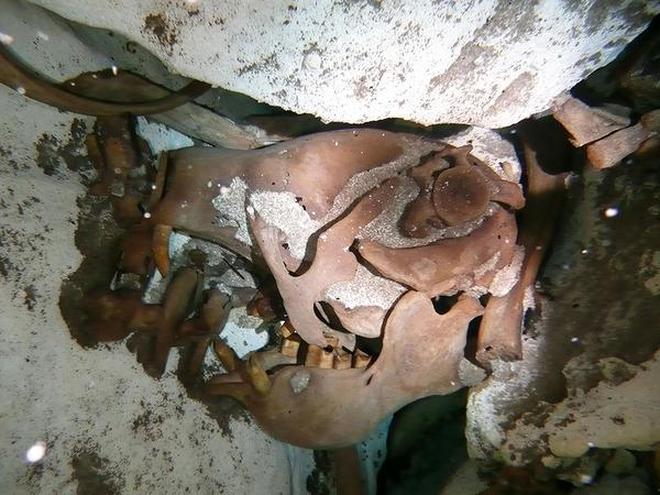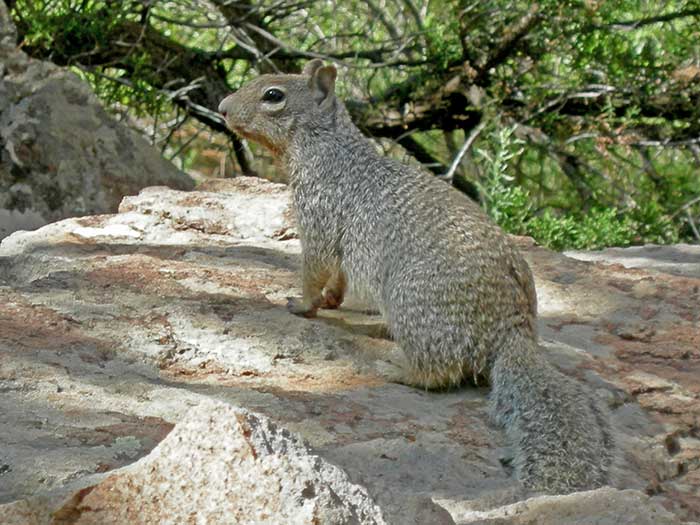My ongoing mission to catalogue the faunal composition of piedmont Georgia as it was during the late Pleistocene is but an educated guess. I base my guess on the lone fossil site in the region plus fossil sites located to the north, south, and west of the piedmont. (See for my list: https://markgelbart.wordpress.com/2013/12/27/if-i-could-live-during-the-pleistocene-part-xii-my-mammal-checklist/ ) I think I know most of the mammal species that occurred here during the Pleistocene, but there were probably species living in the region I never would have guessed. Even in regions with many Pleistocene-aged fossil sites, scientists are still discovering the presence of new species. Within the last 5 years paleontologists identified giant short-faced bear (Arctodus simus) and collared peccary (Tayassu tajacu) specimens in Florida where these species were not formerly known. The dhole (Cuon alpinus) crossed the Bering land bridge sometime during the Pleistocene, yet the only fossil specimens of this species in North America were found at 1 site in Mexico. This means all the dholes that lived between Alaska and Mexico left zero fossil evidence, or at least none that has been found to date. And now, just within the last 2 years, scientists have identified 2 new species of large mammals that lived on the Yucatan peninsula during the late Pleistocene.

Map of the Quintana Roo province on the Yucatan Peninsula. Evidence excavated from sinkhole caves indicates an unique fauna resided here during the late Pleistocene.

Skull of Xibalbaonyx oviceps found in Yucatan sinkhole.
The Yucatan peninsula is dotted with numerous sinkholes and caves because rain water unevenly dissolves underlying limestone bedrock. The sinkholes and caves preserve remains of animals for tens of thousands of years. Cave divers have discovered the bones of gompotheres, glyptodonts, ground sloths, llamas, horses, tapirs, peccaries, spectacled bears, saber-tooths, bobcats, rabbits, fruit bats, and humans in these subterranean spaces. (I’m aware of 4 mostly complete human skeletons found in Yucatan sinkholes and caves–1 dating to the incredibly early date of 14,350 calendar years BP.) Bones of Shasta ground sloths and collared peccaries are among the specimens recovered here, but relatives of each, previously unknown to science, have recently been described in the scientific literature. The new ground sloth species was identified from a specimen found in the Zapote sinkhole. It was a mostly complete skeleton of a sub-adult that weighed at least 500 pounds when it was alive. It is thought to have been adapted to a desert grassland environment. Scientists gave it the unpronounceable scientific name–Xibalbaonyx oviceps. It was closely related to Jefferson’s ground sloth (Megalonyx jeffersonii), a species that occurred all across North America from Florida to Alaska. Perhaps X. oviceps was a desert offshoot of Jefferson’s ground sloth. The new species of peccary was given the more pronounceable scientific name of Mucknalia minimas. I haven’t been able to obtain a copy of either paper describing the new species. When I do I may write an addendum to this blog entry.
The presence of 2 species seemingly endemic to the Yucatan peninsula indicates the region was ecologically unique. The area around the Hoyo del Negro fossil site (See: https://markgelbart.wordpress.com/2015/08/08/the-hoyo-negro-fossil-site-in-yucatan-mexico/ ) was a mix of tropical forest, thorny scrub, and wetland; but further inland desert grassland predominated. I think small sinkhole lakes, like oases, probably existed in drier areas.
Who knows? Maybe the piedmont region of southeastern North America hosted endemic large mammal species during the Pleistocene that are currently unknown to science. Unfortunately, the lack of sites suitable for fossil preservation in the region could keep them cloaked in mystery for eternity.
On an unrelated note: While researching this blog entry, I learned about a llama specimen (the extinct Hemiauchenia macrocephela) found in a Yucatan cave that was apparently butchered, cooked, and eaten by humans. This information doesn’t seem to be generally known in the archaeological literature.
References:
Gonzalez, Arturo: et. al.
“The Arrival of Humans on the Yucatan Peninsula. Evidence from Submerged Caves in the State of Quintana Roo, Mexico”
Current Research in the Pleistocene January 2008
Stinnesbeck, S.; et. al.
“A New Fossil Peccary from the Pleistocene-Holocene Boundary of the Eastern Yucatan Peninsula, Mexico”
Journal of South American Earth Science 2016
Stinnesbeck, S. et. al.
“Xibalbaonyx oviceps, a New Megalonychid Ground Sloth (Folivora: Xenarthan) from the Late Pleistocene of the Yucatan Peninsula, Mexico and its Paleogeographic Significance”
Palz 91 June 2017













